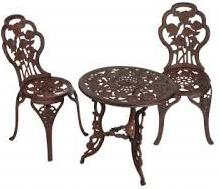 Cast iron is made by casting an alloy of iron, carbon (2.5% -6.67%), manganese and silicon in a shape. It is produced by remelting pig iron, along with coke and limestone.
Cast iron is made by casting an alloy of iron, carbon (2.5% -6.67%), manganese and silicon in a shape. It is produced by remelting pig iron, along with coke and limestone.
In order to get better tensile strengths nickel, molybdenum and silicon may be added to the melt.
The liquid metal is poured in the molding sand. Kitchen pans and stoves are often made of cast iron.
Clay mixed with, or green (wet) sand is used in casting weights up to ± 300kg.
For larger weights are used chemically bonded molding sands or a “brickwork“ in a large hole in the ground.
Malleable cast iron is made by annealing the casting days long under a protective gas mixture, such as nitrogen, at a temperature of 1,100°C. This black malleable cast iron is tougher than gray cast iron and can be hammered and slightly distorted. Of these, gas fittings, wrenches, clamps, links for chains, thick heavy objects such as motor homes and heavy gears, etc. are made.
By annealing cast iron in an oxidizing environment having a temperature of about 1,000°C, white malleable cast iron is created. White pig iron is processed into steel manufacturing due to bring the high carbon content below 2%. We call that unalloyed steel.
Around the end of the 8th century, there were in f Scandinavia smelting furnaces for iron. The Chinese used them as early as the 4th century BC. A regular use we see in Europe after 1380.
In China, there were already in the 1st century water-powered double-acting bellows for the iron industry (1,200 years before Europe).

